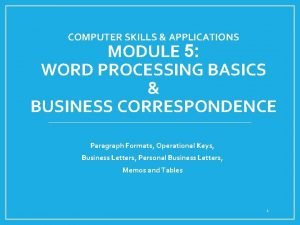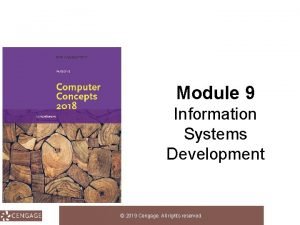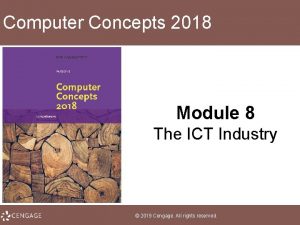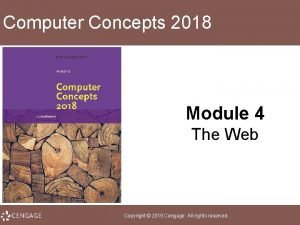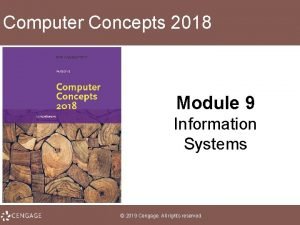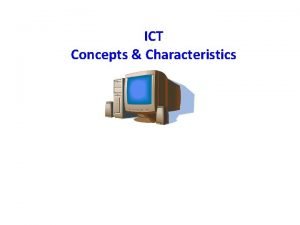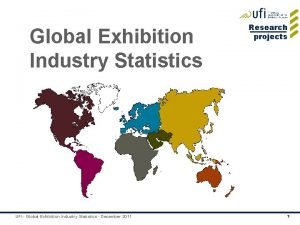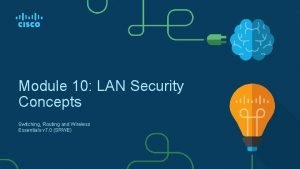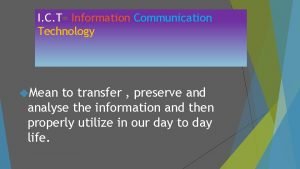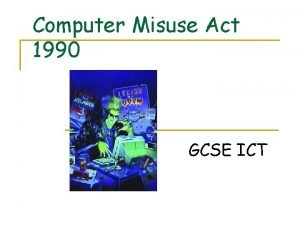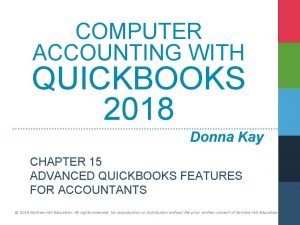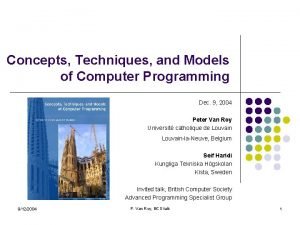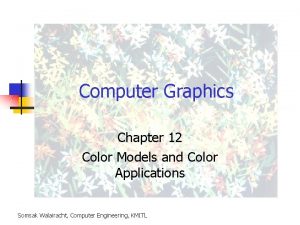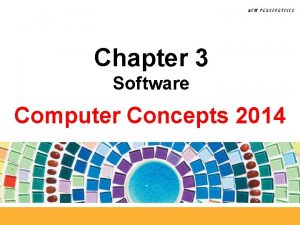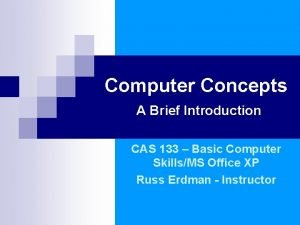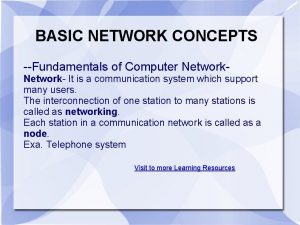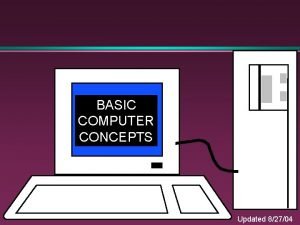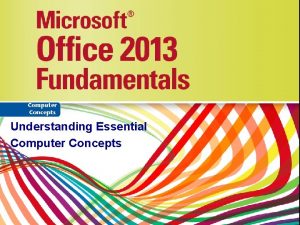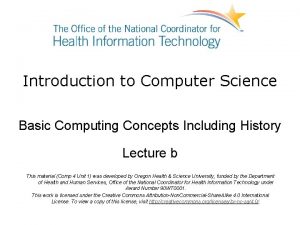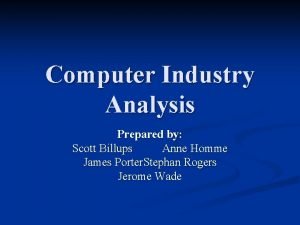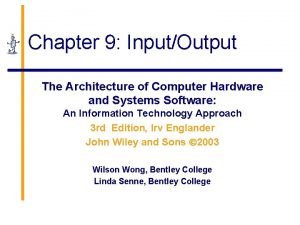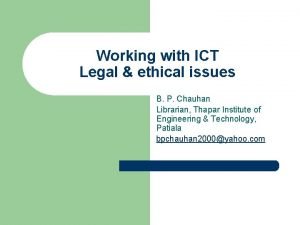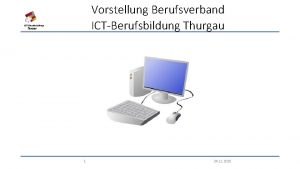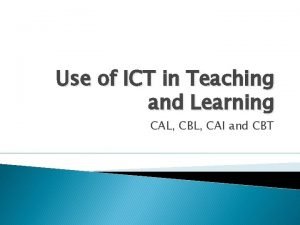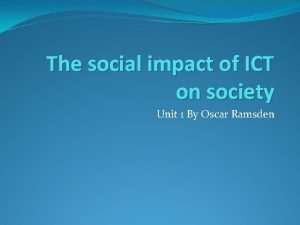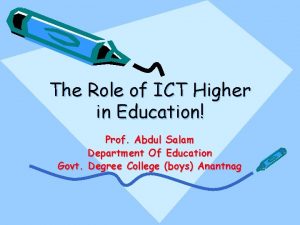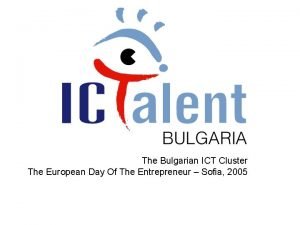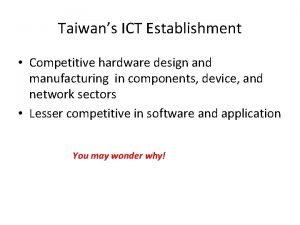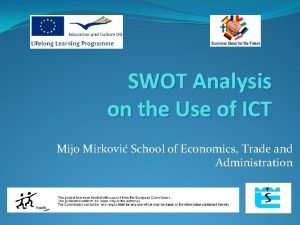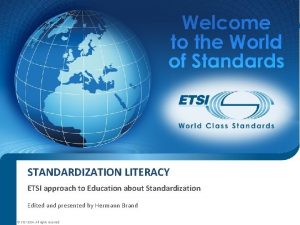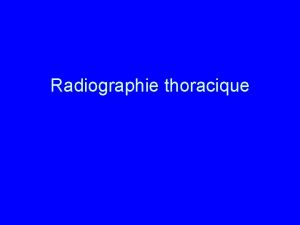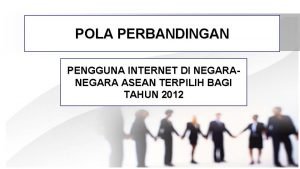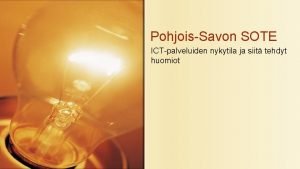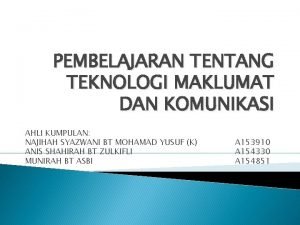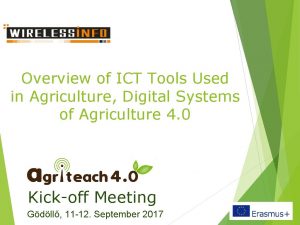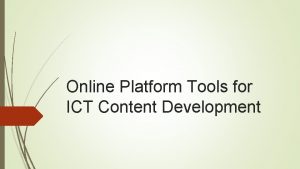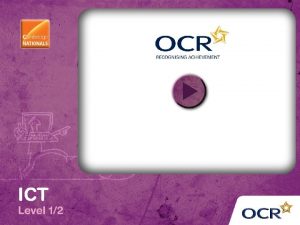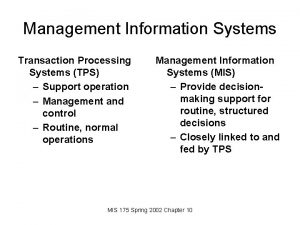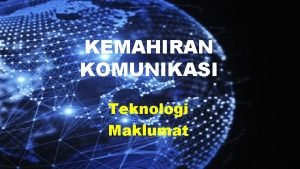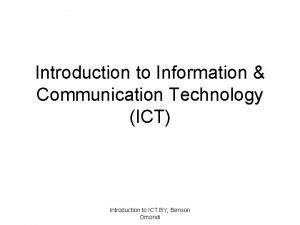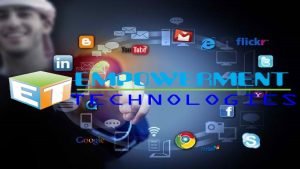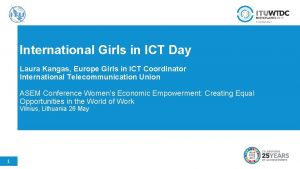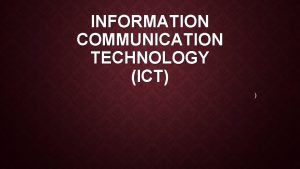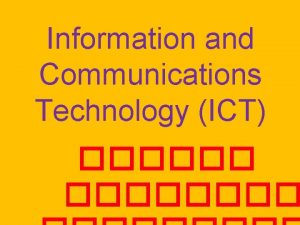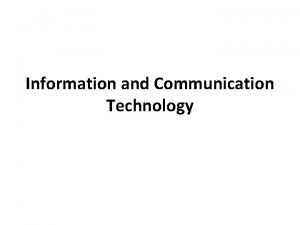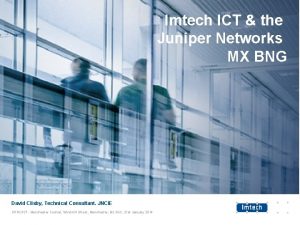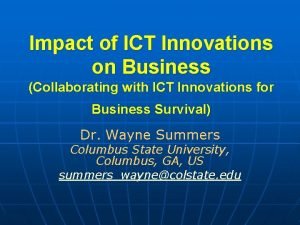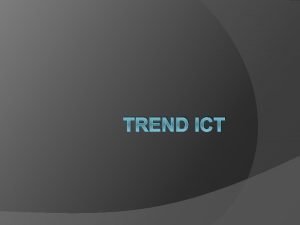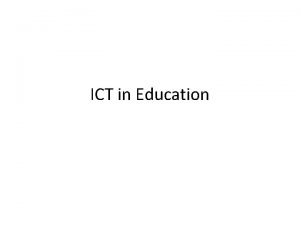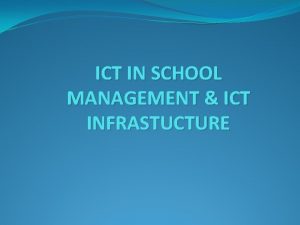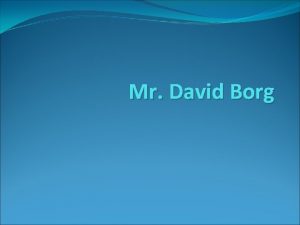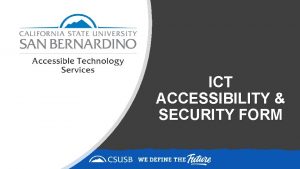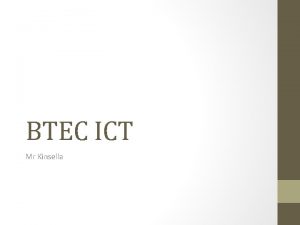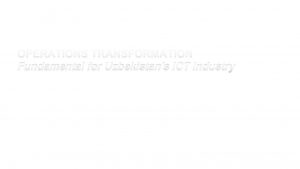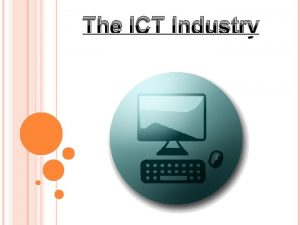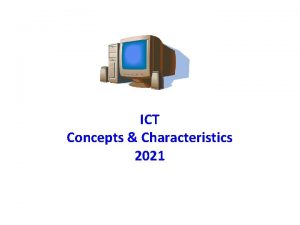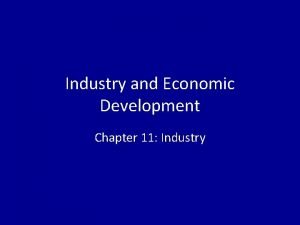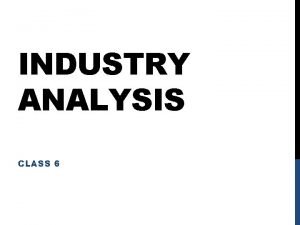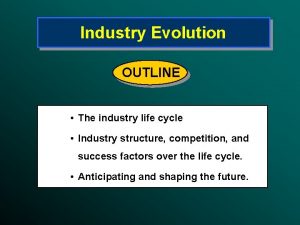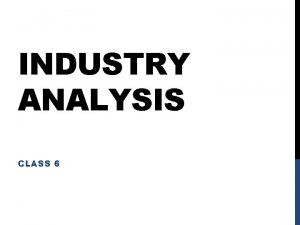Computer Concepts 2018 Module 8 The ICT Industry











































































































- Slides: 107

Computer Concepts 2018 Module 8 The ICT Industry © 2019 Cengage. All rights reserved.

Module Contents • • • Section A: ICT Industry Basics Section B: The Computer Industry Section C: The Telecom Industry Section D: Tech Careers Section E: ICT Laws and Ethics © 2019 Cengage. All rights reserved.

Section A: ICT Industry Basics • • • ICT Core Industries ICT Goods and Services Technology Life Cycles Disruptive Technology ICT and Productivity ICT and National Security © 2019 Cengage. All rights reserved.

Section A: Objectives (1 of 2) • List six core ICT industry components and provide examples of businesses in each • List four reasons why the ICT industry is one of the world’s largest economic sectors • Draw a timeline showing stock market trends for the ICT industry through boom and bust cycles between 1988 and the present year • Give at least three examples of ICT consumer goods and three examples of ICT capital goods • Distinguish between outsourcing and offshoring © 2019 Cengage. All rights reserved.

Section A: Objectives (2 of 2) • Explain how Moore’s law is related to the declining price of ICT products • Draw diagrams representing the product life cycle, Rogers’ bell curve, and the Gartner Hype Cycle • Summarize the global influence of ICT • Provide at least three examples of disruptive technologies and explain their benefits as well as their drawbacks • List four of the six national security functions provided by the ICT industry • Explain the connection between cyberwarfare and the Tallinn Manual © 2019 Cengage. All rights reserved.

ICT Core Industries (1 of 5) • As the computer industry expanded beyond number crunching to data storage and decision support, the IT (Information Technology) industry evolved • The ICT industry is a result of that evolution; a convergence between the IT industry and the telecommunications industry • Companies and businesses create jobs, develop products, and offer services that drive the economy; they are classified into economic sectors according to the types of goods and services they provide © 2019 Cengage. All rights reserved.

ICT Core Industries (2 of 5) • The information industry has three major facets: content, computers, and telecommunications • The focus of Unit 8 is the ICT industry, which is made up of businesses that focus on digital equipment, software, and communications technologies © 2019 Cengage. All rights reserved.

ICT Core Industries (3 of 5) © 2019 Cengage. All rights reserved.

ICT Core Industries (4 of 5) • ICT is one of the world’s largest economic sectors; revenues exceed those of the oil and gas industry and the world’s airlines © 2019 Cengage. All rights reserved.

ICT Core Industries (5 of 5) • The ICT industry has fueled the economies of many countries and was not as deeply affected as some sectors of the economy during the 2009 global recession • The so called dot com bubble was fueled by a frenzy of online business startups called dot-coms • A dot com bubble that began in the late 1990 s burst with devastating effects on ICT stock values; a stock market bubble refers to a sharp rise in stock values that is later followed by a sudden decline © 2019 Cengage. All rights reserved.

ICT Goods and Services (1 of 5) • In economics, goods are things that can be used or consumed, whereas services are intangible actions performed for a consumer • ICT goods and services can be distributed locally, nationally, or internationally and are purchased by individuals and corporations • Consumer goods, such as laptops, are purchased by individuals; capitol goods are raw materials used by businesses to make consumer goods © 2019 Cengage. All rights reserved.

ICT Goods and Services (2 of 5) • The terms outsourcing and offshoring are often used interchangeably, but they are slightly different – Outsourcing is the use of components or labor from outside suppliers – Offshoring relocates business processes, such as manufacturing and customer support, to lower cost locations in other countries © 2019 Cengage. All rights reserved.

ICT Goods and Services (3 of 5) • Until the 1990 s, ICT companies performed all phases of product development in house • Prototyping and mass production moved to Taiwan, then to China • Outsourcing and manufacturing efficiencies contributed to falling prices of ICT goods and services © 2019 Cengage. All rights reserved.

ICT Goods and Services (4 of 5) © 2019 Cengage. All rights reserved.

ICT Goods and Services (5 of 5) In 1995, $1, 800 purchased a desktop computer with a 33 MHz processor, 8 MB of RAM, a 200 MB hard disk, a CD drive, and a bulky CRT monitor with a maximum 1024× 768 resolution. In 2015, $500 paid for a laptop computer with a 1. 7 Ghz processor, 4 GB RAM, a 500 GB hard disk, and an integrated 15” screen with a maximum 1600× 900 resolution. © 2019 Cengage. All rights reserved.

Technology Life Cycles (1 of 3) • The product life cycle (PLC) maps the expected profitability of a product from its inception to its demise © 2019 Cengage. All rights reserved.

Technology Life Cycles (2 of 3) • To try and track a product’s life cycle, analysts and sociologists devised the following: – Moore’s law – Gordon Moore, co founder of Intel Corp. , predicted that technological innovation would double the number of transistors in an integrated circuit every two years without raising its cost – Rogers’ bell curve – frequently used to describe patterns in the way consumers adopt technology products; developed by a team of sociologists including Everett M. Rogers – Gartner Hype Cycle – represents the position of a product during its life cycle of publicity or “hype”; developed by analysts at Gartner, Inc. © 2019 Cengage. All rights reserved.

Technology Life Cycles (3 of 3) © 2019 Cengage. All rights reserved.

Disruptive Technology (1 of 2) • • • Disruptive technology displaces an existing business process, market, industry, or product Flat screen LCD technology replaced CRT displays. Digital photography replaced film photography, which affects camera manufacturers, film manufacturers, and photo processing shops. Computers with word processors replaced typewriters. Digital publishing and Web based access to information have had a devastating effect on newspapers. © 2019 Cengage. All rights reserved.

Disruptive Technology (2 of 2) • • • Movies replaced radio as a form of entertainment. Movies were then disrupted by television, which in turn has been disrupted by download and streaming technology. The telegraph was disrupted by the tele phone system, long distance by Vol. P, and line service by cellular service. Smartphones have the potential to replace devices such as MP 3 players, portable game consoles, point and shoot cameras, personal video players, voice recorders, handheld GPS devices, wristwatches, paper maps, and handheld calculators. © 2019 Cengage. All rights reserved.

ICT and Productivity (1 of 4) • In the context of economics, productivity is a measurement of the amount of output that is produced per unit of input © 2019 Cengage. All rights reserved.

ICT and Productivity (2 of 4) © 2019 Cengage. All rights reserved.

ICT and Productivity (3 of 4) • The World Economic Forum produces an annual report on the global influence of the ICT industry and identifies how well countries leverage ICT technologies © 2019 Cengage. All rights reserved.

ICT and Productivity (4 of 4) • Economists use indicators, such as GDP (gross domestic product), to measure the total output of a nation • Between 2011 and 2013 digitization boosted world economic output by US$193 billion and created 6 million jobs during that period • These factors are a compelling argument for national investment in digital technologies © 2019 Cengage. All rights reserved.

ICT and National Security (1 of 4) • Programs of surveillance, espionage, and sabotage are carried out today using cyberwarfare hacking tools • The ICT industry plays a major role in national security for countries throughout the world • Infiltrating and disabling computers storing sensitive corporate, government, or military data could create chaos and temporarily weaken military defenses © 2019 Cengage. All rights reserved.

ICT and National Security (2 of 4) Jam communications satellites Pilots, ship captains, and military units rely on satellite based GPS, communications, surveillance, navigation, and missile warning. Shut down power grids including nuclear generators Massive power outages can disrupt military defense operations and cause civilian chaos. Disrupt air traffic control Without air traffic control systems, flights are grounded. Shut down water and fuel pipelines A lack of water and fuel creates chaos, especially in major cities. Disrupt financial assets such as banking networks and the stock market Without banking networks, consumers cannot obtain cash or make credit card purchases. Cut off Internet access with DDo. S attacks Both civilian and military communications can be cut off during a massive DDo. S attack. Industrial espionage Cyber break ins at companies that develop military weaponry are especially dangerous. Interfere with SCADA control devices Malware that randomly targets SCADA devices can shut down power plants, dams, and manufacturing facilities. © 2019 Cengage. All rights reserved.

ICT and National Security (3 of 4) • The U. S. Department of Homeland Security identifies six national security functions supplied by the ICT sector: – Provide ICT products and services, such as servers, computers, and routers that are used in military and civilian installations – Provide incident management capabilities – Provide domain name resolution services – Provide identity management and trust support services – Provide Internet based content, information, and communications services – Provide Internet routing, access and communications services © 2019 Cengage. All rights reserved.

ICT and National Security (4 of 4) • Cyberwarfare is the use of ICT technology to carry out politically motivated attacks designed to infiltrate, sabotage, or damage an opponent’s information systems and defensive capabilities • Recent examples of cyberwarfare include the Stuxnet virus that disabled Iranian nuclear centrifuges • The international, non binding document called the Tallinn Manual is a cyber equivalent of the Geneva Convention; it sets out rules for conducting and responding to cyberwarfare © 2019 Cengage. All rights reserved.

Section B: The Computer Industry • • • Manual Calculators Mechanical Calculators Computer Prototypes Commercial Computers Personal Computers © 2019 Cengage. All rights reserved.

Section B: Objectives (1 of 2) • Explain how algorithms apply to manual and mechanical calculators • Name five mechanical calculators that were significant innovations leading to the first computer technology • List five prototype computers and describe how their technology contributed to the technology used in modern day computers • List the key hardware and software developments during the first, second, third, and fourth computer generations • Define von Neumann architecture © 2019 Cengage. All rights reserved.

Section B: Objectives (2 of 2) • Describe the hobbyist phase of the personal computer era • List key hardware devices in the emerging personal computer era © 2019 Cengage. All rights reserved.

Manual Calculators (1 of 2) • A manual calculator is a device that assists in the process of numeric calculations but requires the human operator to keep track of the algorithm • An algorithm is the step by step process by which numbers are manipulated; even simple paper and pencil addition requires an algorithm • A manual calculator called an abacus was used in ancient Rome, Greece, India, China, and Japan; only as the last century came to a close was the abacus replaced by handheld digital calculators © 2019 Cengage. All rights reserved.

Manual Calculators (2 of 2) © 2019 Cengage. All rights reserved.

Mechanical Calculators (1 of 4) • A mechanical calculator implements algorithms autonomously • Mechanical calculators were developed as early as 1623 • Schickard’s Calculator had a series of interlocking gears; each of the ten spokes on a gear represented a digit; every time a gear completed a full circle, it moved the next gear one notch to the left to “carry the 1” • In 1642, a Frenchman named Blaise Pascal developed the Pascaline, a mechanical device that could be used to perform basic arithmetic © 2019 Cengage. All rights reserved.

Mechanical Calculators (2 of 4) • Thomas de Colmar’s Arithmometer became the first mass produced mechanical calculator • Charles Babbage’s Analytical Engine was an all purpose computing device; historians believe that its design embodies many of the concepts that define modern computers, including: – – Memory A programmable processor An output device User definable input of programs and data © 2019 Cengage. All rights reserved.

Mechanical Calculators (3 of 4) • In 1890, Herman Hollerith won the U. S. Census Bureau’s competition to find a way to tabulate the census • Hollerith won the competition with a design for an electronic punched card tabulating device • The device used cards with designated areas representing data fields, such as “nationality”; once punched, the cards were fed into a reader that used an array of metal rods to electronically read data from the cards, tabulate the results, and display them on a series of dials © 2019 Cengage. All rights reserved.

Mechanical Calculators (4 of 4) • Hollerith incorporated the Tabulating Machine Company in 1896; in 1924, the name was changed to International Business Machines—better known as IBM © 2019 Cengage. All rights reserved.

Computer Prototypes (1 of 4) • Figuring out who invented the computer isn’t easy because modern digital computers evolved from prototypes developed between 1936 and 1946 by various individuals and teams • The Atanasoff-Berry Computer (ABC) was the first computing device to use vacuum tubes instead of mechanical switches as processing circuitry • Its design also incorporated the idea of basing calculations on the binary number system • Even though the ABC is often considered the first electronic digital computer, the work of its inventor was largely ignored © 2019 Cengage. All rights reserved.

Computer Prototypes (2 of 4) • Other computer prototypes followed: – Z 3 used vacuum tubes and was designed to work with binary numbers; built in Nazi Germany during World War II – Harvard Mark I officially named the IBM Automatic Sequence Controlled Calculator; used decimal rather than binary representation, which is used by today’s computers – Colossus developed in 1943 by British engineers; an electronic device designed to decode intercepted messages that were sent from the Nazi High Command to field officers © 2019 Cengage. All rights reserved.

Commercial Computers © 2019 Cengage. All rights reserved.

Computer Prototypes (3 of 4) • ENIAC (Electronic Numerical Integrator and Computer) was designed for the U. S. Army during WWII, but wasn’t finished until three months after the war ended • ENIAC was over 100 feet long and 10 feet high and weighed 30 tons! • Containing over 18, 000 vacuum tubes and consuming over 174, 000 watts of power, it was programmed by manually connecting cables and setting 6, 000 switches—a process that usually took two days to complete • ENIAC’s memory held both programs and data. This feature became known as von Neumann architecture after the mathematician, John von Neumann © 2019 Cengage. All rights reserved.

Computer Prototypes (4 of 4) • ENIAC’s first programmers were a team of six women © 2019 Cengage. All rights reserved.

Commercial Computers (1 of 5) • A computer called UNIVAC is considered by most historians to be the first commercially successful digital computer • At 14. 5 feet long, 7. 5 feet high, and 9 feet wide, UNIVAC was physically smaller than ENIAC but more powerful • As technology evolved, relay switches and vacuum tubes were replaced with smaller, less power hungry components © 2019 Cengage. All rights reserved.

Commercial Computers (2 of 5) • First-generation computers, such as UNIVAC, can be characterized by their use of vacuum tubes to store individual bits of data • A vacuum tube is an electronic device that controls the flow of electrons in a vacuum • Each tube can be set to one of two states; one state is assigned a value of 0 and the other a value of 1 © 2019 Cengage. All rights reserved.

Commercial Computers (3 of 5) © 2019 Cengage. All rights reserved.

Commercial Computers (4 of 5) • • • Second-generation computers used transistors instead of vacuum tubes Transistors regulate current or voltage flow and act as a switch for electronic signals Transistors performed functions similar to vacuum tubes, but they were much smaller, cheaper, less power hungry, and more reliable © 2019 Cengage. All rights reserved.

Commercial Computers (5 of 5) • • Third-generation computers became possible in 1958, when integrated circuits were developed IBM 360 offered integrated circuit technology; the first orders for these computers were filled in 1965 Fourth-generation computers appeared in 1971 with the development of the first general purpose microprocessor called the Intel 4004 Intel’s 4004 was smaller than a cornflake but matched the computing power of ENIAC © 2019 Cengage. All rights reserved.

Personal Computers (1 of 6) • • • In the 1970 s, many hobbyists built their own computer systems based on integrated circuit and microprocessor technologies The Mark-8 and the MITS Altair were some of the first personal computers to be developed The Altair was sold as a kit for $395; it had no keyboard, no monitor, and no permanent storage device © 2019 Cengage. All rights reserved.

Personal Computers (2 of 6) • In 1976 Apple Computer Co. was founded by Steve Jobs and Steve Wozniak • Apple released several computers during the 1970 s and 1980 s, including: – Apple I – a kit containing a system board with 4 KB of RAM that sold for $666. 66 – Apple II – featured color graphics, expansions slots, a disk drive, a 1. 07 MHz 6502 processor, and 16 KB of RAM for $1, 195 © 2019 Cengage. All rights reserved.

Personal Computers (3 of 6) – Apple Lisa – introduced in 1983, it made computers even easier for the average person to use; its key feature was a graphical user interface; at $10, 000 it proved too expensive for most consumers – Apple Macintosh – featured a graphical user interface; it became the computer of choice for desktop publishing; cost was $2, 495 © 2019 Cengage. All rights reserved.

Personal Computers (4 of 6) © 2019 Cengage. All rights reserved.

Personal Computers (5 of 6) • • • In 1981, IBM began marketing what it called a personal computer or PC The $3, 000 IBM PC had a 4. 77 MHz Intel 8088 processor, 16 KB of RAM, and floppy disk drives The operating system used on these computers was called PC DOS and was created by a young entrepreneur named Bill Gates © 2019 Cengage. All rights reserved.

Personal Computers (6 of 6) • 1950 1980 – Big computers for big business • 1980 2010 – Big computers for big business § Desktops and laptops for business and personal use • 2010 Future – Big computers for big business § Desktops and laptops for business and personal use o Handheld devices for personal use © 2019 Cengage. All rights reserved.

Section C: The Telecom Industry • • • Telegraph Telephone Radio Cellular Phones Television © 2019 Cengage. All rights reserved.

Section C: Objectives (1 of 2) • List six technologies in the telecommunications sector in the order they were invented • Sketch a timeline of key events in the evolution of the telegraph and show they relate to the Gartner Hype Cycle • Explain the concept of common carrier, and list the communications industries that are included in this classification • Explain how the telephone industry evolved into a significant component of the Internet backbone © 2019 Cengage. All rights reserved.

Section C: Objectives (2 of 2) • Describe at least two contributions that the radio industry made to modern telecommunications • List the major characteristics that differentiate 1 G, 2 G, 3 G, and 4 G cellular service • Sketch a timeline of key events in the television industry and explain how they affect modern Internet access © 2019 Cengage. All rights reserved.

Telegraph (1 of 2) • Telegraphy refers to transmitting text or symbolic information over long distances without the use of a living carrier • The telegraph was built in 1816 using a cable connected at either end to dials marked with the letters of the alphabet • In 1837, U. S. inventor Samuel Morse developed a telegraph system that transmitted data using his Morse code alphabet, a binary encoding system based on dots and dashes © 2019 Cengage. All rights reserved.

Telegraph (2 of 2) © 2019 Cengage. All rights reserved.

Telephone (1 of 3) • A telephone is, very simply, a device that transmits human voices over a distance using cables or airborne signals • The first telephone was invented and patented by Alexander Graham Bell in 1876 • Telephones evolved through several design form factors, including box phones and phones with rotary dialers © 2019 Cengage. All rights reserved.

Telephone (2 of 3) 1890 -1910 Early box phones had no dialing mechanism. Turning the crank alerted the operator, who would ask for the number. 1890 -1930 Candlestick telephones separated the microphone/transmitter from the speaker/receiver. 1940 -1970 Rotary telephones included a rotary dialer; the handset included both a speaker and a microphone. © 2019 Cengage. All rights reserved. 1960 -2010 Trimline telephones introduced touch tone dialing in 1963.

Telephone (3 of 3) • • • A telephone exchange managed connections between callers The world’s first commercial telephone exchange opened in 1877, in Germany Its manual switch board was controlled by a switchboard operator Automated exchanges, developed in 1900, eliminated the need for human operators A common carrier is any person or company that transports goods, passengers, or electronic signals over regular routes at set rates © 2019 Cengage. All rights reserved.

Radio • A radio is a device that sends and receives sound as electromagnetic waves • Like computers, radios originally used vacuum tubes but moved on to new technologies like the transistor • Radio technology is the basis for cell phones, Wi Fi, Bluetooth, and near field communications (NFC)—all indispensible tools of the digital age © 2019 Cengage. All rights reserved.

Cellular Phones (1 of 4) • A cellular telephone is a device that uses a low power radio transmitter to carry out two way voice communications • Two way radio technology went portable during WWII • In 1984 Motorola brought to market the first cell phone model named the Motorola Dyna. TAC 8000 X; it weighed almost 2 pounds and was more than 12 inches long © 2019 Cengage. All rights reserved.

Cellular Phones (2 of 4) © 2019 Cengage. All rights reserved.

Cellular Phones (3 of 4) • 1 G(1984) – Basic voice service – Analog based protocols § 2. 4 kbps • 2 G(1991) – Designed for voice – Improved coverage and capacity – First digital standards(GSM, CDMA) § 64 kbps © 2019 Cengage. All rights reserved.

Cellular Phones (4 of 4) • 3 G(2001) – Designed for voice with some data (multimedia, text, Internet) – First mobile broadband § 2, 000 kbps • 4 G(2011) – Designed primarily for data – IP based protocols(LTE) – True mobile broadband § 100, 000 kbps © 2019 Cengage. All rights reserved.

Television (1 of 2) • Television is a technology designed to send moving images over a distance • Beginning with black and white sets, televisions progressed to colored programming and eventually transitioned to digital television (DTV) • Pay television is a popular subscription service in which consumers pay to receive a selection of television channels © 2019 Cengage. All rights reserved.

Television (2 of 2) © 2019 Cengage. All rights reserved.

Section D: Tech Careers • • Jobs and Salaries Education Certification Resumes © 2019 Cengage. All rights reserved.

Section D: Objectives (1 of 2) • Differentiate between tech sector, STEM, and computer industry careers • List at least seven occupations within a typical IT department • Give an example of the titles used for various levels of career advancement in a tech job © 2019 Cengage. All rights reserved.

Section D: Objectives (2 of 2) • Explain how contract workers differ from employees • List the five computing disciplines recognized by the ACM • Explain the relative merits of a college degree compared to certification, internships, badges, open source projects, and nanodegrees • List six resume formats, and describe when they are best used © 2019 Cengage. All rights reserved.

Jobs and Salaries (1 of 12) • Tech sector careers are part of a broad set of information, technology, and communications industries • The classification technology workers encompasses jobs, such as: – – – Telephone cable installers Radio broadcasters Computer programmers Web designers Software developers © 2019 Cengage. All rights reserved.

Jobs and Salaries (2 of 12) • A different classification of tech sector careers comes from STEM (science, engineering, technology, and math) • STEM is increasingly used to define an employment sector that includes jobs in: – – – Biology Chemistry Information Technology Engineering Math Physics © 2019 Cengage. All rights reserved.

Jobs and Salaries (3 of 12) • A third classification of tech sector careers focuses on computer professionals • A computer professional is anyone whose primary occupation involves the design, configuration analysis, development, modification, testing, or security of computer hardware or software • Many computer professionals work in an IT department —the wing of a business or organization responsible for computer, data, software, and support services; a chief information-officer (CIO) heads the IT department © 2019 Cengage. All rights reserved.

Jobs and Salaries (4 of 12) • A systems analyst investigates the requirements of a business or an organization, its employees, and its customers in order to plan and implement new or improved computer services. This job requires the ability to identify problems and research technical solutions. Good communication skills are essential for interacting with managers and other employees. © 2019 Cengage. All rights reserved.

Jobs and Salaries (5 of 12) • A computer programmer (sometimes described as a programmer/analyst) designs, codes, and tests computer programs. In addition, programmers modify existing programs to meet new requirements or eliminate bugs. Computer programming requires concentration and a good memory for the countless details that pertain to a programming project. Programming projects range from entertainment and games to business and productivity applications. Programmers get satisfaction from devising efficient ways to make a computer perform specific jobs, tasks, and routines. © 2019 Cengage. All rights reserved.

Jobs and Salaries (6 of 12) • A security specialist analyzes a computer system’s vulnerability to threats from viruses, worms, unauthorized access, and physical damage. Security specialists install and configure firewalls and antivirus software. They also work with management and employees to develop policies and procedures to protect computer equipment and data. Computer security jobs are punctuated by crises when a virus hits or a security breach is discovered. A security specialist must have a wide ranging knowledge of computers and communication protocols that can be applied for a quick resolution to any crisis that occurs. © 2019 Cengage. All rights reserved.

Jobs and Salaries (7 of 12) • A database administrator analyzes a company's data to determine the most effective way to collect and store it. Database administrators create databases, data entry forms, and reports. They also define backup procedures, provide access to authorized users, and supervise the day to day use of databases. • A network administrator plans, installs, and maintains one or more local area networks and may also manage cloud resources. These specialists provide net work accounts and access rights to approved users. © 2019 Cengage. All rights reserved.

Jobs and Salaries (8 of 12) They troubleshoot connectivity problems and respond to requests from network users for new software. Network administrators might be responsible for maintaining the security of a network, plus they often pick up Web master duties to maintain an organization's Web site. • A computer operator works with system software for network servers, mainframes, and supercomputers. Computer operators monitor computer performance, install software patches and upgrades, perform backups, and restore data as necessary. © 2019 Cengage. All rights reserved.

Jobs and Salaries (9 of 12) • A technical support specialist troubleshoots hardware and software problems. Good interpersonal skills and patience are required for this job. • A Web site developer creates, tests, posts, and modifies Web pages. A good sense of design and artistic talent are required for this job, along with an understanding of how people use graphical user interfaces. Familiarity with Web tools, such as HTML and Java. Script, is becoming more important for this job, as is a knowledge of computer programming and database management. © 2019 Cengage. All rights reserved.

Jobs and Salaries (10 of 12) • A social networking analyst manages an organization's online reputation by establishing and maintaining social media sites and evaluating analytics to support its mission. This occupation requires familiarity with social networking sites and an ability to interpret statistical metrics obtained from analytical tools. © 2019 Cengage. All rights reserved.

Jobs and Salaries (11 of 12) • • The U. S. Bureau of Labor and Statistics predicts that in the decade 2012– 2022, employment in the information and technology sector could grow by 18%, generating 650, 000 new jobs An unknown number of these jobs will be outsourced, which may negatively affect U. S. workers but will benefit offshore workers © 2019 Cengage. All rights reserved.

Jobs and Salaries (12 of 12) • Workers in many industries are interested in becoming a telecommuter who uses available technology to work from home or an off site location • Telecommuters tend to be more productive and work longer hours because they have no commute time and are not interrupted by routine office chatter • Finding a job in the IT industry is similar to finding a job in most other industries – Use online job listing sites (Tech Jobs, Computer. Jobs. com) – Network (in person or via email) – Use social networking tools (Linked. In) © 2019 Cengage. All rights reserved.

Education (1 of 4) • Computer science is only one of many computer related degrees that colleges and universities offer • According to the Association for Computing Machinery (ACM), there are five major computing disciplines: – – – Computer engineering Computer science Information systems Information technology Software engineering © 2019 Cengage. All rights reserved.

Education (2 of 4) DEGREE CURRICULUM CAREERS Computer engineering focuses on the design of computer hardware and peripheral devices, often at the chip level. This degree involves basic studies in calculus, chemistry, engineering, physics, computer organization, logic design, computer architecture, microprocessor design, and signalprocessing. Working at a chip manufacturer, such as Intel, Motorola, IBM, AMD, or Texas Instruments. Students learn how to design new computercircuits, microchips, and other electroniccomponents, plus they learn how to designnew computer instruction sets and combineelectronic or optical components to providepowerful, cost effective computing. Computer science focuses on computer architecture and how to program computers to make them work effectively and efficiently. This degree involves courses in programming, algorithms, software development, computer architecture, data representation, logic design, calculus, discrete math, and physics. Computer programmers, with good possibilities for advancement to software engineers, object oriented/ GUI developers, and project managers in technical applications development. © 2019 Cengage. All rights reserved.

Education (3 of 4) DEGREE Information systems degree programs, typically offered by a university's college of business, focus on applying computers to business problems. CURRICULUM CAREERS Students investigate the fundamental theories of how computers solve problems, and they learn how to write application programs, system software, computer languages, and device derivers. Also, theorists, inventors, and researchers in fields as diverse as artificial intelligence, virtual reality, and computer games. degree involves coursework in business, accounting, computer programming, communications, systems analysis, and human psychology. Programming or technical support jobs, with good possibilities for advancement to systems analyst, project manager, database administrator, network manager, or other management positions. This degree is recommended for students who want to become computer professionals but lack strong math aptitude. © 2019 Cengage. All rights reserved.

Education (4 of 4) DEGREE CURRICULUM CAREERS Information technology degree programs focus on computer equipment and soft ware used by businesses. This degree involves hands on coursework with hardware, networks, Web pages, multimedia, email systems, and security. Network specialists and administrators, systems analysts, forensic technicians, and help desk technicians. Software engineering takes a disciplined approach to developing software that is reliable, efficient, affordable, user friendly, and scalable. This degree involves studying statistics, software design, programming, systems analysis and courses from information systems and computer science curricula. Programmers, analysts, or managers on large scale, safety critical applications. © 2019 Cengage. All rights reserved.

Certification (1 of 4) • Approximately 300 computer related certification exams are offered in areas of specialty that range from desktop publishing to network installation • Certification exams can be divided into several categories, including the following: – – – General computer knowledge Software applications Database administration Networking and cloud Computer hardware Computer security © 2019 Cengage. All rights reserved.

Certification (2 of 4) • AP Exam – Students who pass the AP Computer Science exam in high school have a head start on their college level courses and may increase their chances of acceptance into an elite computer science program. • Open Source Projects – Participants in open source community projects get experience and make con nections with other professionals that can be valuable resources during a job hunt. You can find projects at Git. Hub, Source. Forge, Open. Hatch, and Open Hub. © 2019 Cengage. All rights reserved.

Certification (3 of 4) • Internships – Internships are resume builders. Look for opportunities during summer break or for an after school job. Working in the field before graduating adds relevant work experience to your list of qualifications. • Badges – Badges are inspired by videogame awards and Boy Scout patches. Online education providers, such as Khan Academy and Open. Study, offer badges to students who complete various milestones. © 2019 Cengage. All rights reserved.

Certification (4 of 4) • Nanodegrees – Nanodegrees are awarded upon completion of one or more targeted online courses. These offshoots of MOOCs (massive open online courses) offer self study training to career minded individuals who might not have the time or means to complete a traditional degree program. © 2019 Cengage. All rights reserved.

Resumes (1 of 3) • Job seekers need to produce resumes in a variety of formats, including the following: – – – Print Email HTML Linked. In Online job service Web portfolio (a hypertext version of your resume) © 2019 Cengage. All rights reserved.

Resumes (2 of 3) • Be clear and concise. – Eliminate unnecessary words, phrases, and sentences. – Be efficient with words when describing tasks, duties, titles, and accomplishments. – Be brief and to the point without selling yourself short. • Place the most Important point first. – List your qualifications by importance and relevance to the job you seek. – Summarize skills at the top of the resume. – Use a bold font to emphasize skills and accomplishments that are required for the position you seek. © 2019 Cengage. All rights reserved.

Resumes (3 of 3) – Include pertinent information about training, certification, and professional affiliations, but avoid personal information, such as church affiliation and hobbies, that is not directly related to the job. • Use language effectively. – – – Target terms and wording to prospective employers. Use industry jargon wherever appropriate. Use action verbs to maintain the reader's interest. Use past and present tenses consistently. Double check grammar and spelling. When posting information in a database, use nouns that describe your skills. © 2019 Cengage. All rights reserved.

Section E: ICT Laws and Ethics • • ICT Laws ICT Ethics Ethical Decision Making Whistleblowing © 2019 Cengage. All rights reserved.

Section E: Objectives (1 of 2) • List at least five significant areas of information technology law • Explain the purpose of the following: Computer Fraud and Abuse Act, Electronic Communication Privacy Act, Communications Decency Act, Digital Millennium Copyright Act, and USA PATRIOT Act • Supply an example of an ethical dilemma that involves copyright • Supply examples of ethical dilemmas that involve privacy and confidentiality © 2019 Cengage. All rights reserved.

Section E: Objectives (2 of 2) • Explain what technology professionals should consider before using resources at work for their personal projects • Explain the context in which technology professionals have social responsibility • List five resources for ethical decision making • Provide at least three examples of whistleblowing related to information technology • Explain the ethical dilemma faced by whistleblowers © 2019 Cengage. All rights reserved.

ICT Laws (1 of 2) • Information technology law is the legal framework that applies to the collection, storage, and distribution of digital information • Some of the most significant areas of information technology law include the following: – – – – Copyright and intellectual property Domain names Patents Cybercrime Software and computer contracts Privacy Communication © 2019 Cengage. All rights reserved.

ICT Laws (2 of 2) © 2019 Cengage. All rights reserved.

ICT Ethics (1 of 2) • The term professional ethics refers to on the job choices and actions that reflect a person’s values • Confidentiality is the obligation not to disclose willingly any information that should be kept private • Proprietary information includes knowledge about company finances, procedures, products, and research that competitors would find valuable • A non-compete clause is designed to prevent employees from divulging proprietary information to competitors © 2019 Cengage. All rights reserved.

ICT Ethics (2 of 2) • It’s never a good idea to use facilities at work for personal activities unless you have a specific agreement with your employer and your activities do not breach your employment contract © 2019 Cengage. All rights reserved.

Ethical Decision Making (1 of 3) • Ethical decisions that you make on the job can have long term consequences for your career and lifestyle, so it is important to approach these decisions seriously • Use the following strategies when making decisions at work: – Talk to people whose judgment you respect – Consider what the most ethical person you know would decide to do – Think about what you would do if your actions were made public – Look at the problem from the opposite perspective – Consult a code of professional ethics © 2019 Cengage. All rights reserved.

Ethical Decision Making (2 of 3) • A code of ethics is a set of guidelines designed to help professionals thread their way through a sometimes tangled web of ethical on the job decisions • Some codes of ethics are short and concise, whereas others are long and detailed • Most codes contain principles similar to those from the Computer Ethics Institute (CEI) • Do not use a computer to harm other people • Do not interfere with other people's computer work • Do not snoop around in other people's files © 2019 Cengage. All rights reserved.

Ethical Decision Making (3 of 3) • • Do not use a computer to steal Do not use a computer to bear false witness Do not use or copy software for which you have not paid Do not use other people's computer resources without authorization • Do not appropriate other people's intellectual output. • Think about the social consequences of the programs you write • Use a computer in ways that show consideration and respect © 2019 Cengage. All rights reserved.

Whistleblowing (1 of 3) • A widely accepted definition of whistleblowing is the disclosure by an employee (or professional) of confidential information that relates to some danger, fraud, or other illegal or unethical conduct connected with the workplace • A whistleblower is someone in an organization who decides to speak out against on the job activities that are contrary to the mission of the organization or threaten the public interest © 2019 Cengage. All rights reserved.

Whistleblowing (2 of 3) • Employee advocates have the following suggestions for reducing the risk of career repercussions that are often experienced by whistleblowers: – Examine your motives – Try the normal chain of command – Collect evidence to back up your accusations – Record events as they unfold – Act ethically © 2019 Cengage. All rights reserved.

Whistleblowing (3 of 3) – Be ready to accept repercussions – Establish a support network – Consult a lawyer – Consider your strategy © 2019 Cengage. All rights reserved.
 Word processing packages
Word processing packages Module 5 computer concepts exam
Module 5 computer concepts exam Module 8 computer concepts skills training
Module 8 computer concepts skills training Copyright search
Copyright search Module 9 computer concepts
Module 9 computer concepts Dada la siguiente secuencia rusia 2018 rusia 2018
Dada la siguiente secuencia rusia 2018 rusia 2018 What are the characteristics of ict
What are the characteristics of ict Global exhibition industry statistics 2018
Global exhibition industry statistics 2018 Module quiz - lan security concepts
Module quiz - lan security concepts Industry module
Industry module C device module module 1
C device module module 1 What is ict in computer
What is ict in computer Teach ict computer misuse act
Teach ict computer misuse act Computer accounting with quickbooks 2018
Computer accounting with quickbooks 2018 Evolution of computer architecture
Evolution of computer architecture Concepts techniques and models of computer programming
Concepts techniques and models of computer programming Cmy and hsv color model
Cmy and hsv color model Computer concepts 2014
Computer concepts 2014 Basic concepts of computer science
Basic concepts of computer science Micro computer concepts
Micro computer concepts Basic concepts of computer networks
Basic concepts of computer networks Basic computer concepts
Basic computer concepts Understanding essential computer concepts
Understanding essential computer concepts Computer science basic concepts
Computer science basic concepts Hát kết hợp bộ gõ cơ thể
Hát kết hợp bộ gõ cơ thể Ng-html
Ng-html Bổ thể
Bổ thể Tỉ lệ cơ thể trẻ em
Tỉ lệ cơ thể trẻ em Gấu đi như thế nào
Gấu đi như thế nào Chụp tư thế worms-breton
Chụp tư thế worms-breton Bài hát chúa yêu trần thế alleluia
Bài hát chúa yêu trần thế alleluia Môn thể thao bắt đầu bằng chữ f
Môn thể thao bắt đầu bằng chữ f Thế nào là hệ số cao nhất
Thế nào là hệ số cao nhất Các châu lục và đại dương trên thế giới
Các châu lục và đại dương trên thế giới Công thức tiính động năng
Công thức tiính động năng Trời xanh đây là của chúng ta thể thơ
Trời xanh đây là của chúng ta thể thơ Mật thư anh em như thể tay chân
Mật thư anh em như thể tay chân 101012 bằng
101012 bằng Phản ứng thế ankan
Phản ứng thế ankan Các châu lục và đại dương trên thế giới
Các châu lục và đại dương trên thế giới Thơ thất ngôn tứ tuyệt đường luật
Thơ thất ngôn tứ tuyệt đường luật Quá trình desamine hóa có thể tạo ra
Quá trình desamine hóa có thể tạo ra Một số thể thơ truyền thống
Một số thể thơ truyền thống Bàn tay mà dây bẩn
Bàn tay mà dây bẩn Vẽ hình chiếu vuông góc của vật thể sau
Vẽ hình chiếu vuông góc của vật thể sau Nguyên nhân của sự mỏi cơ sinh 8
Nguyên nhân của sự mỏi cơ sinh 8 đặc điểm cơ thể của người tối cổ
đặc điểm cơ thể của người tối cổ Ví dụ giọng cùng tên
Ví dụ giọng cùng tên Vẽ hình chiếu đứng bằng cạnh của vật thể
Vẽ hình chiếu đứng bằng cạnh của vật thể Phối cảnh
Phối cảnh Thẻ vin
Thẻ vin đại từ thay thế
đại từ thay thế điện thế nghỉ
điện thế nghỉ Tư thế ngồi viết
Tư thế ngồi viết Diễn thế sinh thái là
Diễn thế sinh thái là Dạng đột biến một nhiễm là
Dạng đột biến một nhiễm là Số nguyên là gì
Số nguyên là gì Tư thế ngồi viết
Tư thế ngồi viết Lời thề hippocrates
Lời thề hippocrates Thiếu nhi thế giới liên hoan
Thiếu nhi thế giới liên hoan ưu thế lai là gì
ưu thế lai là gì Sự nuôi và dạy con của hươu
Sự nuôi và dạy con của hươu Sự nuôi và dạy con của hổ
Sự nuôi và dạy con của hổ Hệ hô hấp
Hệ hô hấp Từ ngữ thể hiện lòng nhân hậu
Từ ngữ thể hiện lòng nhân hậu Thế nào là mạng điện lắp đặt kiểu nổi
Thế nào là mạng điện lắp đặt kiểu nổi Pc industry analysis
Pc industry analysis Input output module in computer architecture
Input output module in computer architecture Difference between a computer and computer system
Difference between a computer and computer system Difference between a computer and computer system
Difference between a computer and computer system Computer input devices drawing
Computer input devices drawing Basic structure of computer in computer organization
Basic structure of computer in computer organization Diff between computer architecture and organization
Diff between computer architecture and organization Interrupt cycle flow chart
Interrupt cycle flow chart Basic computer organization
Basic computer organization Legal and ethical issues in use of ict
Legal and ethical issues in use of ict What ict
What ict Ict berufsbildung thurgau
Ict berufsbildung thurgau Cal in ict
Cal in ict Social impact of ict
Social impact of ict Social impact of ict in education
Social impact of ict in education Conclusion ict
Conclusion ict Ict cluster bulgaria
Ict cluster bulgaria Benefits of ict in design and manufacturing
Benefits of ict in design and manufacturing Ict
Ict Etsi - ict standards
Etsi - ict standards Recent developments in ict
Recent developments in ict Index cardiothoracique calcul
Index cardiothoracique calcul Masalah dalam memajukan ict
Masalah dalam memajukan ict Istekki kokemuksia
Istekki kokemuksia Kepentingan teknologi maklumat dan komunikasi
Kepentingan teknologi maklumat dan komunikasi Bahan ajar berbasis ict adalah
Bahan ajar berbasis ict adalah Ict tools used in agriculture
Ict tools used in agriculture Ict content tools
Ict content tools Ocr national ict
Ocr national ict Tps in ict
Tps in ict Lerndokumentation zimmermann
Lerndokumentation zimmermann Kebaikan ict
Kebaikan ict Introduction of ict
Introduction of ict Diverse information sharing through universal web access *
Diverse information sharing through universal web access * International girls in ict day
International girls in ict day Canalizaciones ict
Canalizaciones ict Ict stands for
Ict stands for Ict consists of
Ict consists of Ictmeaning
Ictmeaning Information and communication technology capability.
Information and communication technology capability. Juniper mx bng
Juniper mx bng Ict innovations for business
Ict innovations for business
